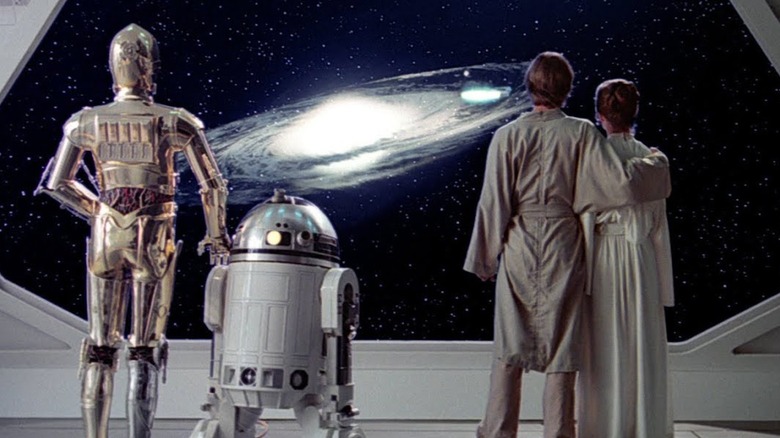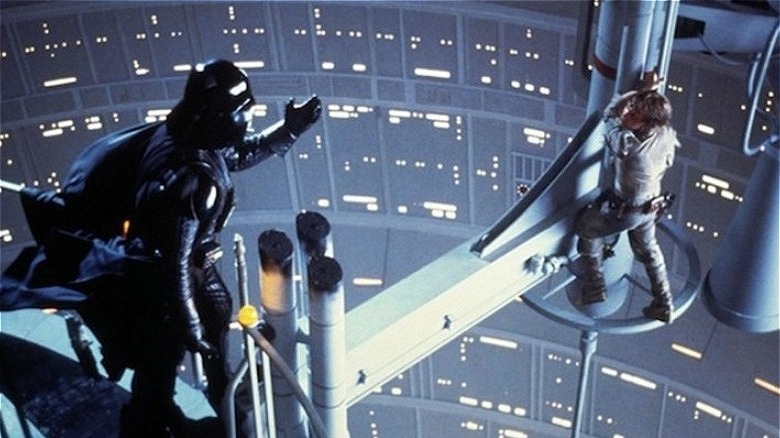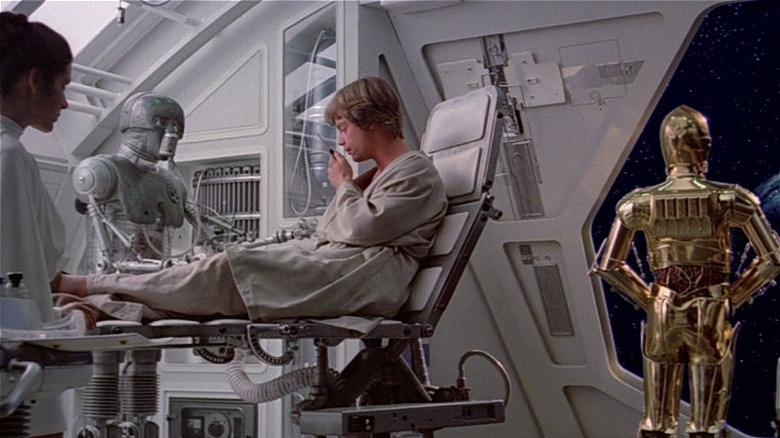Why The Empire Strikes Back Added Its Final Scene Four Months After Filming Wrapped
It's difficult to select the most iconic moment in "The Empire Strikes Back" considering just how big the film is. A cinematic juggernaut that forever changed the way Hollywood blockbusters told stories, "Empire" is lauded for its epic plot structure and turned what could have been a depressing and frustrating cliffhanger ending into an emotionally satisfying coda. But the final scene of the film, which lingers on Luke, Leia, R2-D2, and C-3PO as they watch Chewbacca and Lando fly off with the Millennium Falcon to search for Han, was added months after principal photography, proving that it's never too late to add a cherry on the proverbial sundae.
"The Empire Strikes Back" has become such a cultural milestone at this point that it's easy to forget just how shocking that final act was to audiences when the film was first released. Cliffhangers weren't exactly a new concept, especially in the episodic serial films that George Lucas held so dear. It's just that the open-ended conclusion of "Empire" raised the stakes of an already-epic story centered around a group of characters that fans had fallen in love with. The evil Empire has essentially won, leaving the heroes everyone has become emotionally attached to in the most dire straits of their adventure. There needed to be some way to leave a glimmer of hope in such a grim situation.
A moment of new hope
After four months of post-production, the team working on the film finally figured out how to convey this spark of light. According to a Tweet from Luke Skywalker himself, actor Mark Hamill, there were worries that the conclusion was too much of a bummer, and leaned in to torturing the heroes we love. The remedy was an additional shoot:
Filmed 4 months after we wrapped principal photography on #ESB, it wasn't a "re-shoot", it was an added scene. Concerned about the downbeat ending & thorough defeat of the protagonists, they wanted to add an uplifting moment of hope & rejuvenation to reassure the audience. https://t.co/VIMbC3YprU pic.twitter.com/MG41dr8fgu
— Mark Hamill (@HamillHimself) March 8, 2022
That addition probably worked out for the best, too. Our heroes are defeated for the moment, but persistent on making a comeback while the Rebel fleet carries on, all while John Williams' score swells to remind us that it's not over yet. The scene might have been an idea that popped up late in the making, but it represents hope in the face of utter darkness, the ethos of the entire original "Star Wars" trilogy.
Gluing a trilogy together
"The Empire Strikes Back" practically created the mold for middle films within trilogies and, later, the first part of a two-part finale within bigger franchises. "Avengers: Infinity War," "Harry Potter and the Deathly Hollows: Part 1," "The Lord of the Rings: The Two Towers" — the list goes on. These entries find our heroes in dire situations, often the low point of their entire journey, and it's up to the next film in the series to resolve this conflict. The genius of "Empire" is that the film also serves as a neat and tidy arc for a section of a longer story. By the end, Luke learns that Darth Vader is his father and rejects his offer to join the dark side, Leia and Han's love for each other is made clear, and the traitor Lando rethinks his relationship with the Empire and joins the Rebels for real. These character development moments are important enough steps to merit their own individual films, but there's enough plot left in the overall story to let these newly formed characterizations take hold and evolve even further.
The ending scene acts as a symbol of all this, showing the characters standing together and looking towards the future. It's a crucial visual that ties "Empire" together emotionally and thematically, so it's a bit wild to think that it wasn't even considered to be a part of the film until late into post-production. "The Empire Strikes Back" is a huge movie both in scale and in behind-the-scenes mechanics, so perhaps it in a way it makes sense that one of its most important parts moved into place slowly and carefully.


